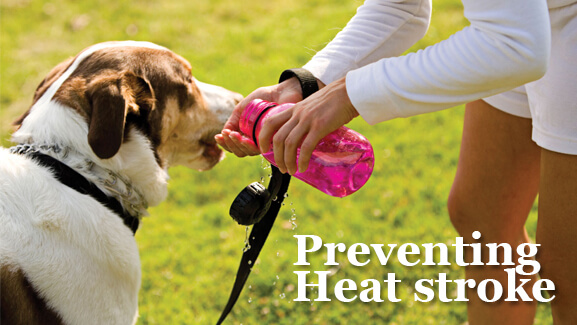Heat Stroke and Your Dog
With unseasonably high temperatures and predictions that this will be a record-setting summer, there has been a lot of media attention lately on dogs and the heat. It is important for all dog owners to understand the risks and take the necessary steps to keep their pets safe and comfortable.
What is heat stroke?
Heat stroke occurs in dogs when they aren’t able to regulate their body temperature to around 38-39 degrees Celsius. They develop hyperthermia, an elevated body temperature where the body produces or absorbs more heat than it can dissipate. Dogs that are overweight or older are at higher risk.
Heat stroke is caused by:
- Heat itself
- Poor ventilation
- Excessive humidity
- Over-exertion
What to watch for
Some signs of heat stroke include panting rapidly, thick, ropey saliva, and bright red gums. If you see any of these signs, you should take action immediately and:
- Get the pet out of the heat and into a shaded area, preferably with air conditioning. Check their temperature, if possible. Run cool water over the back of your pet’s head, armpits, tummy, and in between the back legs.
- Rub an alcohol solution on their belly or groin area.
- Do not immerse the dog in cold water.
- Rehydrate the dog; let them drink as much cold water as they can. You can also add some electrolytes, like Gatorade, to the water.
- If your dog’s body temperature rises further (41 degrees C or higher), he will go into shock, become weak and dizzy, and experience vomiting and diarrhea. If you see any of these symptoms, it’s vital to seek medical attention immediately to prevent disability or death. Get to a vet as soon as possible!
Preventative measures
People are sometimes shocked at how quickly and easily dogs can come down with heat stroke, especially compared to humans. The fact is, it’s a lot more difficult for a dog to cool down than a person, unless the dog gets some help from their two-legged friend.
Here are some simple and easy steps to avoid dehydration in your pet:
- If you have a dog with long, thick hair, keep it trimmed. Not too much though, as their skin is quite sensitive and burns easily.
- Make sure your pooch has enough cool water, particularly if he is spending a lot of time outdoors.
- You should always provide a shady area to give your dog a break from sun exposure.
- If your pet is staying indoors, keep the air conditioning on. If that’s not possible, provide a cooling mat (which can even work when your dog spends time outdoors).
- Never leave a pet inside of a car. Cars heat up quickly during the summer, and they are sometimes as much as 10 degrees hotter than outside.
- Be compassionate: bring your dog inside on really hot days, even if he protests.
- Exercise during the day increases your dog’s chances of dehydration and heat stroke. Leave exercise or walks for early mornings or late evenings when temperatures are cooler.
When it comes to heat stroke, practice the same safety measures for your pets as you would for a small child. If you wouldn’t leave a child in a hot car unattended, you shouldn’t leave your dog there either.
Your turn
Heat stroke can be scary for a pet owner, but it’s also very preventable. If you have any questions about what was discussed, feel free to leave your thoughts in the comment section below and I will be sure to respond promptly. If you found this post useful, please share it with your friends on your social media networks! Also, feel free to make an appointment today for your pet, or just come by and visit. We’ll be happy to see you!!

